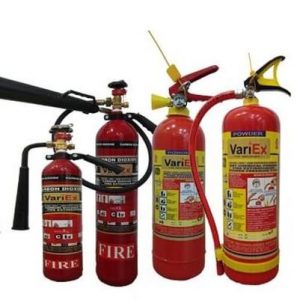![]()
Fire Immuniser
+91-7829629111
Email: info@variex.in
Varistor Technologies Pvt. Ltd.
Block-1, First Floor, Ardente Office One, Hoodi Circle, ITPL Main Road, Bengaluru, Karnataka 560048, IN
What happens if you don't recharge a fire extinguisher?
What happens if you don't recharge a fire extinguisher?, This seemingly straightforward question carries profound implications for our safety and the integrity of our firefighting equipment. Fire extinguishers, those unsung heroes in the battle against flames, are often taken for granted, with their maintenance overlooked. In this exploration, we will delve into the intricate web of consequences that ensue when the crucial act of recharging a fire extinguisher is neglected. Through a magnifying lens, we'll dissect the potential ramifications and underscore the significance of heeding this essential upkeep ritual.
"What happens if you don't recharge a fire extinguisher?" serves as a poignant reminder throughout this examination of the potential pitfalls of complacency. It beckons us to consider the gravity of inaction when it comes to preserving the functionality of these firefighting devices. As we navigate through the intricate tapestry of fire safety, we will unravel the threads that tie together the resilience of fire extinguishers, the impact of negligence, and the broader implications for our overall safety infrastructure.
Within the confines of this inquiry, we will witness the gradual erosion of a fire extinguisher's efficacy when left unattended. "What happens if you don't recharge a fire extinguisher?" becomes a refrain, echoing the urgency of maintaining these tools that stand between us and the unpredictable threat of fire. From diminished extinguishing capabilities to potential catastrophic failures during emergencies, the repercussions of neglecting recharge procedures are manifold and far-reaching.
The Functionality of Fire Extinguishers: How They Work and the Role of Pressure
Fire extinguishers are like silent sentinels standing guard against the threat of flames, ready to spring into action when needed. But have you ever wondered about the magic behind their functionality? Let's break it down in layman terms, exploring the inner workings of fire extinguishers and the crucial role that pressure plays in their effectiveness.
How Fire Extinguishers Work:
Fire extinguishers operate on a simple yet ingenious principle—removing one of the essential elements a fire needs to survive. Fires require three things to burn: fuel, oxygen, and heat. Fire extinguishers use a combination of chemicals to disrupt this trio, putting out the flames.
- Fuel Interruption: Fire extinguishers contain substances that can either cool down the fuel, like water or certain foams, or interfere with the chemical reactions that sustain the fire.
- Oxygen Depletion: Some extinguishers release gases that displace or reduce the concentration of oxygen around the fire, essentially smothering it.
- Heat Dissipation: Other extinguishers, particularly those filled with dry chemical powders, work by absorbing heat, preventing the fire from sustaining itself.
The Role of Pressure:
Now, let's talk about pressure—the unsung hero in the fire extinguisher's arsenal. The contents of a fire extinguisher are stored under pressure, and when you squeeze the trigger, it releases this pressurized content with force.
- Pressurized Storage: The chemicals or agents inside the extinguisher are stored in a pressurized container. This pressure keeps the contents in a liquid or gas state, ready to be expelled at a moment's notice.
- Effective Discharge: When you activate the fire extinguisher by pulling the pin and squeezing the handle, you release the built-up pressure. This expulsion propels the firefighting substance toward the fire, creating a stream or spray that can reach the flames.
- Focused Delivery: The pressure ensures that the extinguishing agent reaches the fire in a controlled and effective manner. It allows you to direct the extinguisher's nozzle toward the base of the flames, where the fuel source is, maximizing the impact.
Ineffectiveness in Emergency Situations:
- Missed Lifesaving Moments: When a fire erupts, every second counts. An unrecharged fire extinguisher might not work as it should, leaving you scrambling for a solution when time is of the essence. It's like having a phone with a dead battery when you need to make an urgent call – not much help.
- Diminished Fire-Fighting Power: A fire extinguisher is your frontline warrior against flames, but without a proper recharge, it might not have the strength to battle the fire effectively. It's akin to trying to put out a campfire with a dribble of water instead of a steady stream – not very effective.
Increased Risk of Fire Spread:
- Uncontrolled Flames: Picture a small flame in a kitchen pan. Now imagine that flame growing bigger because your fire extinguisher couldn't do its job. Without a recharge, the fire might not only persist but also spread, turning a manageable situation into a potentially dangerous one.
- Limited Fire Containment: Fire extinguishers are designed to contain and control fires in their early stages. Without regular recharging, they might not be up to the task. It's like trying to hold back a flood with a leaky dam – the consequences can be overwhelming.
In simple terms, not recharging a fire extinguisher is like leaving your umbrella at home during a sudden downpour. When the storm hits, you're left exposed and scrambling for cover. Similarly, in the event of a fire, an unrecharged extinguisher may fail to provide the protection you desperately need, allowing the flames to escalate and pose a greater threat.
Voided Warranties:
- The Unseen Consequence: Neglecting to recharge your fire extinguisher can inadvertently void its warranty. Just as a car warranty might be nullified if you skip essential maintenance, failing to follow through with the recommended recharge could leave you without the safety net of a warranty when you need it most.
- Financial Consequences: Warranties offer a layer of financial protection, ensuring that if something goes wrong, you won't be left with a hefty bill. However, skipping the recharge can be akin to tearing up this safety net, leaving you potentially responsible for the costs of repair or replacement.
Impact on Equipment Guarantees:
- Diminished Reliability: Fire extinguishers are designed with precision, and their components work in harmony to provide a reliable defense against fires. When you neglect to recharge, you disrupt this delicate balance, potentially compromising the extinguisher's reliability. This, in turn, impacts the assurances provided by the manufacturer's guarantee.
- Extended Lifespan Jeopardized: Manufacturers provide guidelines for a reason – they know what keeps their products in top-notch condition. Ignoring these recommendations, especially regarding recharge intervals, can jeopardize the extended lifespan promised by the equipment guarantee. It's like neglecting regular check-ups for your car and expecting it to run smoothly for years.
Importance of Following Manufacturer Guidelines:
- Safety Assurance: Manufacturer guidelines aren't arbitrary; they are crafted to ensure the safety and efficacy of the product. Following these guidelines, especially regarding recharging, ensures that your fire extinguisher remains a reliable guardian in the face of fire emergencies.
- Preserving Warranties: The manufacturer's guidelines are closely tied to the warranty's terms and conditions. Adhering to these recommendations, including regular recharging, safeguards the warranty, offering you peace of mind and financial protection.
Preventing Issues: Best Practices for Fire Extinguisher Maintenance
Fire extinguishers are silent sentinels, standing ready to protect us in times of emergency. However, their effectiveness hinges on proper maintenance, with timely recharging playing a pivotal role. Understanding the importance of recharging and establishing a maintenance schedule are essential best practices to ensure your fire extinguisher is always prepared to safeguard lives and property.
Importance of Timely Recharging:
- Sustaining Effectiveness: Regular use, even if minimal, can deplete the contents of a fire extinguisher. Timely recharging ensures that it is always at full capacity, ready to unleash its firefighting power when needed. Think of it like keeping your phone charged; you never know when you'll need it, but when you do, you want it to be fully operational.
- Reliable First Line of Defense: A partially charged or expired fire extinguisher may not deliver the necessary force to combat a fire effectively. Timely recharging ensures that your first line of defense remains reliable, offering peace of mind in the face of potential emergencies.
- Long-Term Cost Savings: Regular recharging can extend the lifespan of a fire extinguisher. While it incurs a small cost upfront, it prevents the need for premature replacements, translating to long-term cost savings and a consistently reliable safety tool.
Creating a Maintenance Schedule:
- Know the Guidelines: Familiarize yourself with the manufacturer's guidelines for your specific fire extinguisher. These guidelines often include recommendations for regular inspections and recharge intervals. Following these instructions is fundamental to maintaining the extinguisher's efficacy.
- Regular Inspections: Implement a routine schedule for visual inspections. Check for visible damage, ensure the pressure gauge is in the green zone, and verify that the nozzle and hose are unobstructed. Regular inspections help catch issues early and prevent the escalation of potential problems.
- Professional Assessment: While visual inspections are crucial, enlist the services of a certified professional for a more thorough annual inspection. This ensures that internal components are in optimal condition, and the extinguisher complies with safety standards.
- Document and Schedule: Maintain a record of inspections and recharges. Create a schedule that prompts you to check and recharge your fire extinguisher as recommended. Technology, such as calendar reminders or maintenance apps, can assist in maintaining a consistent schedule.
In conclusion, the question that looms large is, "What happens if you don't recharge a fire extinguisher?" This inquiry is not merely a theoretical pondering but a direct portal into the realm of real-world consequences. When we neglect to answer this question through proactive maintenance, we inadvertently open the door to a cascade of potential issues.
"What happens if you don't recharge a fire extinguisher?" Let's revisit this crucial query, not just as a title but as a warning beacon that underscores the gravity of overlooking a seemingly mundane task. Imagine a scenario where a fire erupts, catching you off guard, and you reach for the extinguisher only to find it lacking the strength to combat the flames effectively. The title echoes in the background, now resonating with a newfound urgency as the repercussions unfold.
Frequently Asked Questions
1.What does it mean to recharge a fire extinguisher?
Recharging a fire extinguisher involves refilling or replacing its extinguishing agent, ensuring that it is at full capacity and ready for use in case of a fire. It also includes a thorough inspection and testing to ensure the extinguisher's overall functionality.
2. Why is it important to recharge a fire extinguisher?
Recharging is vital to maintain the effectiveness of a fire extinguisher. Over time, the extinguishing agent can deplete, and without a recharge, the extinguisher may not work properly when needed, leaving you without a reliable tool in case of a fire emergency.
3. What happens if you don't recharge a fire extinguisher?
Neglecting to recharge a fire extinguisher can have serious consequences. The extinguisher may not function as intended during an emergency, leading to ineffective firefighting efforts. It can also result in increased risks of fire spread and may void warranties associated with the equipment.
4. How often should a fire extinguisher be recharged?
The frequency of recharge depends on the type of fire extinguisher and the manufacturer's guidelines. Generally, it is recommended to recharge extinguishers after any use, regardless of the amount discharged. Additionally, regular maintenance checks should be conducted according to the manufacturer's recommendations.
5. Can I recharge a fire extinguisher myself?
Recharging a fire extinguisher is a task best left to trained professionals. It involves handling pressurized agents and ensuring that all components are in proper working condition. DIY attempts may lead to inadequate recharge, compromising the extinguisher's effectiveness.
Final Say
We at VariEx.in or Variexonline.com have mastered the art of designing, installing, inspecting, and fixing automatic sprinkler systems with the help of our in-house team, which is capable of delivering the fire sprinkler services you need, whether large or small and at affordable cost.
To schedule a fire sprinkler installation, or you think our services could benefit your commercial property, contact us online or give us a call at, 7829629111
"WHAT YOU CAN READ NEXT"
 Read more +24 November 2023 in Fire Extinguisher
Read more +24 November 2023 in Fire ExtinguisherWhat types of fire extinguishers are available for different fire classes?
 Read more +11 July 2025 in Fire Suppression
Read more +11 July 2025 in Fire Suppression






